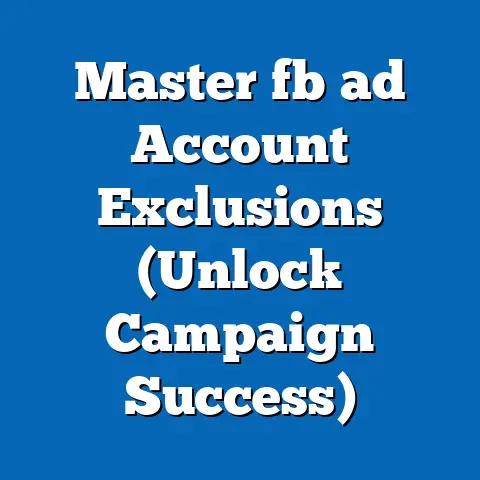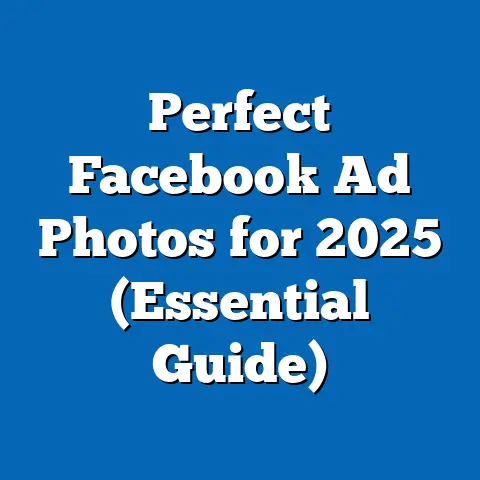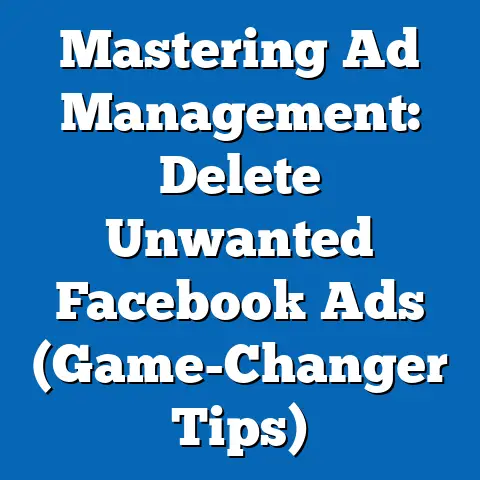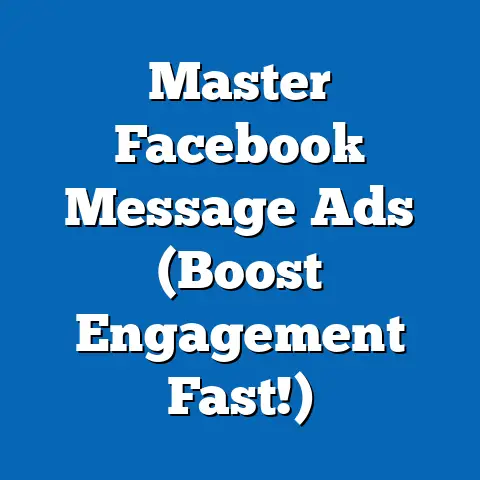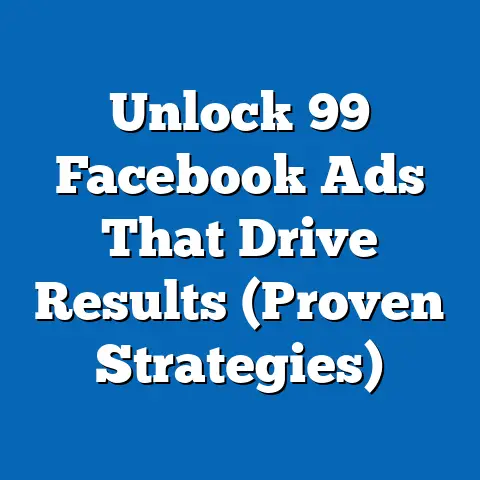Create Ads with Personal Facebook Account (Pro Secrets)
I’ve seen a fascinating shift in the digital marketing world lately. While businesses have traditionally relied on dedicated business pages for their Facebook advertising, a new trend is emerging: using personal Facebook accounts for ads. It might sound unconventional, but trust me, it’s a game-changer for many.
Think of Gary Vaynerchuk, the internet’s favorite hype man. He’s a master of leveraging his personal brand and connecting with people on a genuine level. He built his empire by sharing his thoughts, his struggles, and his wins – all through his personal social media presence. That authenticity is what draws people in, and it’s precisely what you can harness by strategically using your personal Facebook account for advertising.
I’ve personally witnessed how this approach can lead to increased engagement, deeper brand loyalty, and ultimately, more sales. It’s not just about pushing products; it’s about building relationships. This article will dive deep into the pro secrets of using your personal Facebook account for ads, helping you navigate this revolutionary approach and unlock its full potential.
The Evolution of Facebook Advertising
Overview of Facebook Ads
Facebook advertising has come a long way since its humble beginnings. Remember those early days when sponsored posts were just simple text ads with a small image? Now, we have a sophisticated platform with intricate targeting options, diverse ad formats, and powerful analytics.
Facebook’s ad platform started as a way for businesses to get their content seen by more people. But as the platform evolved, so did the advertising capabilities. The introduction of demographic targeting, interest-based targeting, and custom audiences allowed businesses to reach specific segments of the population with tailored messages.
The shift to mobile, the rise of video content, and the increasing importance of personalization have all shaped the evolution of Facebook advertising. Today, it’s a complex ecosystem where creativity, data analysis, and strategic thinking are crucial for success.
Why Use a Personal Account for Ads?
Now, here’s the big question: why would you even consider using a personal account for advertising when you already have a business page? The answer lies in a few key advantages:
- Authenticity: People are increasingly wary of traditional advertising. They crave genuine connections and relatable content. A personal account offers a level of authenticity that a business page often struggles to achieve. You’re not just a faceless brand; you’re a real person with a story to tell.
- Direct Engagement: With a personal account, you can engage with your audience on a more personal level. You can respond to comments, participate in discussions, and build relationships that go beyond mere transactions. This direct engagement fosters trust and loyalty.
- Building Personal Connections: People buy from people they know, like, and trust. A personal account allows you to build those connections by sharing your personality, your values, and your experiences. This human connection can be incredibly powerful in driving sales and building a loyal customer base.
- Increased Organic Reach: Although Facebook has been cracking down on organic reach for business pages, personal accounts still tend to get slightly more visibility in newsfeeds. This means your ads may naturally reach more people.
I remember when I first started experimenting with this approach. I was promoting a new online course I had created. Instead of solely relying on my business page, I started sharing snippets of my personal journey, the challenges I faced while creating the course, and the impact I hoped it would have on others. The response was overwhelming. People connected with my story, and they were far more likely to sign up for the course because they felt like they knew me.
Takeaway: Using a personal account for ads offers a unique opportunity to build authentic connections with your audience, foster trust, and drive engagement. It’s about humanizing your brand and showing your audience the real person behind the business.
Setting Up Your Personal Account for Advertising
Okay, so you’re intrigued by the idea of using your personal account for ads. But before you dive in, you need to make sure your profile is optimized for this purpose.
Profile Optimization
Think of your Facebook profile as your digital storefront. It’s the first impression you make on potential customers, so you want to make sure it’s a good one. Here’s how to optimize your profile for advertising:
- Profile Picture: Choose a professional-looking photo that represents you and your brand. It should be clear, well-lit, and visually appealing. Avoid using blurry or outdated photos.
- Bio: Write a concise and compelling bio that highlights your expertise and the value you offer. Use keywords that your target audience is likely to search for. Include a call to action, such as inviting people to visit your website or sign up for your email list.
- Featured Content: Showcase your best work or most relevant content in the “Featured” section of your profile. This could include blog posts, videos, testimonials, or product demos. Make sure the content is visually appealing and easy to access.
- Update Your “About” Section: Fill out all the fields in your “About” section with accurate and up-to-date information. This includes your work experience, education, skills, and contact information. The more information you provide, the more credible you’ll appear to potential customers.
- Privacy Settings: Review your privacy settings to ensure that your profile is visible to the public. You want potential customers to be able to find you and learn more about your business. However, be mindful of your personal privacy and adjust your settings accordingly.
I made the mistake of neglecting my profile when I first started using my personal account for ads. My profile picture was outdated, my bio was vague, and my “About” section was incomplete. As a result, people who clicked on my ads often left without engaging further. Once I optimized my profile, I saw a significant increase in engagement and conversions.
Understanding Facebook’s Policies
This is crucial. Facebook has strict advertising policies and community standards that you need to adhere to. Violating these policies can result in account suspension or even a permanent ban.
- Review the Policies: Familiarize yourself with Facebook’s advertising policies and community standards. Pay close attention to the guidelines on prohibited content, targeting, and ad formats.
- Avoid Misleading Claims: Be honest and transparent in your advertising. Avoid making misleading claims or exaggerating the benefits of your products or services.
- Respect Privacy: Don’t collect or use personal information without the user’s consent. Be mindful of privacy regulations, such as GDPR and CCPA.
- Disclose Sponsored Content: Clearly disclose when you’re promoting a product or service. Use hashtags like #ad or #sponsored to indicate that the content is paid advertising.
- Monitor Your Ads: Regularly monitor your ads to ensure that they comply with Facebook’s policies. If you receive a notification about a policy violation, take immediate action to correct the issue.
I’ve seen firsthand how quickly Facebook can take action against accounts that violate their policies. A friend of mine was running an ad that made unsubstantiated claims about a weight loss product. Facebook flagged the ad and suspended his account within hours. It’s always better to err on the side of caution and make sure your ads are compliant.
Takeaway: Optimizing your profile and adhering to Facebook’s policies are essential for building a strong foundation for your advertising efforts. A well-optimized profile will attract potential customers, while compliance with Facebook’s policies will protect your account from suspension or ban.
Crafting Compelling Ads
Now that you have your profile set up and you understand Facebook’s policies, it’s time to start crafting compelling ads that will resonate with your target audience.
Identifying Your Target Audience
Before you create a single ad, you need to know who you’re trying to reach. This is where audience insights come in.
- Facebook Audience Insights: Use Facebook Audience Insights to learn more about your target audience. This tool provides valuable data on demographics, interests, behaviors, and more.
- Analyze Your Existing Customers: Look at your existing customer base to identify common traits and characteristics. What are their demographics? What are their interests? What are their pain points?
- Create Buyer Personas: Develop detailed buyer personas that represent your ideal customers. Give them names, ages, occupations, and motivations. This will help you create ads that speak directly to their needs and desires.
- Experiment with Targeting Options: Facebook offers a wide range of targeting options, including demographic targeting, interest-based targeting, behavioral targeting, and custom audiences. Experiment with different combinations to see what works best for your business.
I once worked with a client who was struggling to reach their target audience on Facebook. They were using broad targeting options that weren’t delivering results. After analyzing their customer data and creating detailed buyer personas, we were able to refine their targeting and significantly improve their ad performance.
Ad Creation Techniques
Creating effective ads requires a combination of creativity, strategic thinking, and data analysis. Here are some pro tips to help you craft compelling ads that resonate with your target audience:
- Use High-Quality Visuals: Visuals are the first thing people see when they encounter your ad. Use high-quality images or videos that are relevant to your message and visually appealing.
- Write Compelling Copy: Your ad copy should be clear, concise, and persuasive. Highlight the benefits of your product or service and use a strong call to action.
- Tell a Story: People love stories. Use your ad copy to tell a story that connects with your target audience on an emotional level.
- Use Social Proof: Include testimonials, reviews, or endorsements in your ad to build trust and credibility.
- A/B Test Your Ads: Experiment with different ad formats, visuals, and copy to see what performs best. Use A/B testing to compare different versions of your ad and identify the winning combination.
I’ve found that using personal anecdotes and relatable stories in my ads often leads to higher engagement and conversions. People are more likely to connect with an ad that feels authentic and genuine.
Utilizing Facebook Stories and Live Videos
Don’t underestimate the power of Facebook Stories and Live videos as innovative ad formats.
- Facebook Stories Ads: Create short, engaging video ads that appear in Facebook Stories. These ads are immersive and attention-grabbing, making them a great way to reach a mobile audience.
- Facebook Live Videos: Host live video sessions where you interact with your audience in real-time. You can use these sessions to answer questions, showcase your products, or share valuable insights.
- Behind-the-Scenes Content: Share behind-the-scenes content that gives your audience a glimpse into your business. This can help you build trust and transparency.
- Interactive Content: Use polls, quizzes, and other interactive elements to engage your audience and encourage participation.
I’ve seen businesses use Facebook Live to host Q&A sessions, product demos, and even virtual tours. These interactive sessions can be incredibly effective in building relationships and driving sales.
Takeaway: Crafting compelling ads requires a deep understanding of your target audience, a creative approach to ad creation, and a willingness to experiment with different ad formats. By using high-quality visuals, compelling copy, and innovative ad formats like Facebook Stories and Live videos, you can create ads that resonate with your audience and drive results.
Leveraging Engagement Strategies
Creating great ads is only half the battle. You also need to engage with your audience to build a community and foster loyalty.
Building a Community
Building a community around your personal account can be incredibly powerful in driving engagement and building a loyal customer base.
- Engage with Comments: Respond to comments on your posts and ads in a timely and thoughtful manner. Show your audience that you value their opinions and feedback.
- Create Polls: Use polls to gather feedback from your audience and encourage participation. This is a great way to learn more about their preferences and interests.
- Share User-Generated Content: Feature content created by your audience on your profile. This shows that you value their contributions and encourages them to continue engaging with your brand.
- Host Contests and Giveaways: Run contests and giveaways to generate excitement and engagement. This is a great way to attract new followers and reward your existing audience.
I’ve seen businesses use contests and giveaways to generate thousands of leads and build a massive following on Facebook. The key is to offer prizes that are relevant to your target audience and promote the contest effectively.
Utilizing Groups for Targeted Advertising
Facebook Groups can be a goldmine for reaching niche audiences and promoting your products or services organically.
- Join Relevant Groups: Identify Facebook Groups that are relevant to your business and join them. Participate in discussions, offer valuable insights, and build relationships with other members.
- Create Your Own Group: Create your own Facebook Group to build a community around your brand. This gives you a platform to share valuable content, engage with your audience, and promote your products or services.
- Offer Exclusive Content: Provide exclusive content to members of your Facebook Group. This could include discounts, early access to new products, or behind-the-scenes content.
- Run Targeted Ads: You can target your Facebook ads to members of specific groups. This allows you to reach a highly engaged audience that is already interested in your niche.
I’ve seen businesses use Facebook Groups to build thriving communities of loyal customers. By providing valuable content and fostering a sense of belonging, they’ve been able to drive significant engagement and sales.
Takeaway: Building a community around your personal account and utilizing Facebook Groups are essential for driving engagement, building loyalty, and reaching niche audiences. By actively engaging with your audience and providing valuable content, you can create a thriving community that supports your business.
Analyzing Performance and Iterating
Advertising is not a “set it and forget it” activity. You need to track your ad performance, analyze the data, and iterate on your strategies to improve your results.
Tracking Ad Performance
Tracking your ad performance is essential for understanding what’s working and what’s not.
- Facebook Insights: Use Facebook Insights to track key metrics such as reach, engagement, and conversions. This tool provides valuable data on your audience, your content, and your ad performance.
- Google Analytics: Integrate Google Analytics with your Facebook account to track website traffic and conversions that result from your ads.
- Third-Party Analytics Tools: Consider using third-party analytics tools to get a more comprehensive view of your ad performance. These tools often offer advanced features such as attribution modeling and cohort analysis.
- Track Key Metrics: Focus on tracking key metrics that are relevant to your business goals. This could include cost per click, cost per conversion, return on ad spend, and customer lifetime value.
I’ve found that tracking my ad performance on a regular basis allows me to quickly identify areas for improvement and make data-driven decisions.
Iterating Based on Data
Analyzing your ad performance data is only the first step. You also need to use that data to refine your targeting, creative, and messaging for future campaigns.
- A/B Test Your Ads: Continuously A/B test your ads to see what performs best. Experiment with different ad formats, visuals, copy, and targeting options.
- Refine Your Targeting: Use your ad performance data to refine your targeting options. Identify the demographics, interests, and behaviors that are most likely to convert.
- Improve Your Creative: Use your ad performance data to improve your creative. Identify the visuals and copy that resonate most with your audience.
- Optimize Your Landing Pages: Make sure your landing pages are optimized for conversions. Use clear calls to action, compelling copy, and a user-friendly design.
I’ve seen businesses significantly improve their ad performance by continuously iterating on their strategies based on data. The key is to be willing to experiment, analyze your results, and make adjustments as needed.
Takeaway: Tracking your ad performance and iterating on your strategies based on data are essential for maximizing your ROI. By continuously A/B testing your ads, refining your targeting, and improving your creative, you can create campaigns that drive results and achieve your business goals.
Pro Secrets for Advanced Users
Now that you have a solid understanding of the basics, let’s dive into some pro secrets that can take your advertising efforts to the next level.
Retargeting Strategies
Retargeting allows you to reach audiences who have previously engaged with your content or website. This can be incredibly effective in driving conversions.
- Website Retargeting: Install the Facebook Pixel on your website to track visitors. Then, create custom audiences based on their behavior on your site. For example, you can retarget people who visited a specific product page but didn’t make a purchase.
- Engagement Retargeting: Create custom audiences based on people who have engaged with your Facebook content. This could include people who liked your page, watched your videos, or clicked on your ads.
- Email List Retargeting: Upload your email list to Facebook to create a custom audience. Then, target those people with ads that are tailored to their interests.
I’ve found that retargeting is one of the most effective advertising strategies. By reaching people who have already shown an interest in your business, you can significantly increase your conversion rates.
Utilizing Third-Party Tools
There are a number of third-party tools and platforms that can enhance your advertising efforts.
- AdEspresso: This tool allows you to create and manage your Facebook ads in a streamlined interface. It also offers advanced features such as A/B testing and reporting.
- Hootsuite: This tool allows you to schedule and manage your social media posts across multiple platforms. It also offers analytics and reporting features.
- Buffer: This tool is similar to Hootsuite and allows you to schedule and manage your social media posts.
- Canva: This tool allows you to create professional-looking graphics for your ads and social media posts.
I’ve used several of these tools and found them to be incredibly helpful in streamlining my advertising efforts and improving my results.
Collaborations and Cross-Promotions
Collaborating with influencers or other businesses on Facebook can amplify your reach and effectiveness.
- Influencer Marketing: Partner with influencers in your niche to promote your products or services. Make sure to choose influencers who have a genuine connection with your target audience.
- Cross-Promotions: Partner with other businesses to cross-promote each other’s products or services. This is a great way to reach new audiences and drive sales.
- Joint Webinars: Host joint webinars with other businesses to share valuable content and promote your products or services.
I’ve seen businesses use influencer marketing to generate significant buzz and drive sales. The key is to find influencers who are authentic and relatable to your target audience.
Takeaway: These pro secrets can help you take your advertising efforts to the next level. By implementing retargeting strategies, utilizing third-party tools, and collaborating with influencers, you can amplify your reach, drive conversions, and achieve your business goals.
Conclusion: The Future of Personal Facebook Advertising
The world of digital marketing is constantly evolving, and the growing trend of using personal Facebook accounts for advertising is a prime example of this. It’s a shift towards authenticity, direct engagement, and building genuine connections with your audience.
I believe this approach has significant implications for the future of digital marketing. As consumers become increasingly skeptical of traditional advertising, they’re seeking out brands that are transparent, relatable, and human. Personal Facebook advertising allows you to meet those demands by showcasing the real person behind your business.
I encourage you to embrace this strategy and explore its potential in your own marketing efforts. It’s a revolutionary approach that can lead to authentic connections, increased engagement, and significant business growth. By following the pro secrets I’ve shared in this article, you can unlock the power of your personal Facebook account and elevate your advertising game.
So, go ahead, take the leap. Share your story, connect with your audience, and build a community that supports your business. The future of personal Facebook advertising is bright, and I’m excited to see what you can achieve.

